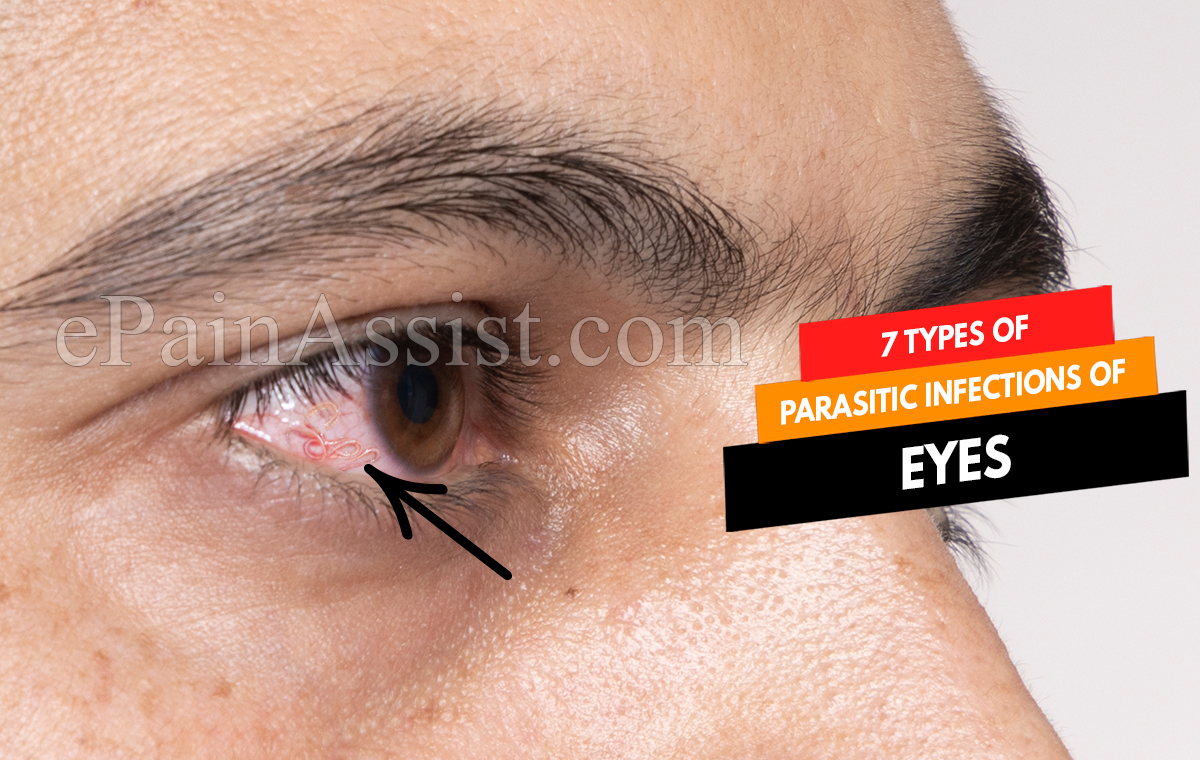Parasites can infect humans and once inside the body they travel to different organs including the eyes. If not treated, the infection can lead to eye problems and in some cases blindness. Parasites live outside or inside an organism and depend on the host for nutrients. Most parasites cause damage to the host. The Center for Disease Control and Prevention states there are 3 parasites that are responsible for causing disease in a human.(1) These are:
- Protozoa, a single-celled organism, multiplies inside the body and leads to serious infections.
- Helminths, these include flatworms, flukes, and roundworms
- Ectoparasites, which are the blood-sucking invertebrates and include mosquitoes, lice, ticks, and mites
Most parasites cause damage to the host by secreting toxic substances. These substances destroy tissue or cause inflammation.
Following are the types of parasitic infections that can infect the eyes.

7 Types of Parasitic Infections of Eyes and their Symptoms
Acanthamoeba Keratitis
Acanthamoeba keratitis is a serious eye infection that is caused by a single-celled organism called an amoeba.
Amoeba is present in bodies of water, soil, and air. Acanthamoeba infects the cornea, a transparent covering of the eye and if not treated it can lead to severe pain and in some cases loss of vision. It is estimated that 85% of this infection develops in people who wear contact lenses.(2)
The symptoms of Acanthamoeba keratitis include:
- Eye pain
- Light sensitivity
- Blurred vision
- Eye redness
- Feeling of something in the eye
- Excessive staining
Toxoplasmosis
Toxoplasmosis gondii is a protozoan parasite. It is known to cause infection in 11% of people 6 years of age and older.(3) If a person develops a toxoplasmosis infection during pregnancy, it can affect the eyes of the fetus. People can get this infection by eating undercooked meat or shellfish. It can also be passed on through the feces of cats and dogs. Most people with toxoplasmosis do not experience any symptoms. Some may feel that they are having flu.
Symptoms of toxoplasmosis include:
- Reduced vision
- Tearing
- Eye redness
- Pain due to bright light
Demodicosis
Demodex folliculorum are the tiny mites that live in the hair follicles in humans. They are mostly harmless, but if their number increase, they can cause harm to the eyes.
People with demodicosis may have these mites in large number in the eyelashes, which may cause the following symptoms:
- Corneal scarring
- Conjunctivitis
- Blepharitis or eyelid swelling
African Eye Worm
African eye worm or loiasis is caused by loa loa, a parasitic worm. People who live or visit rainforests are repeatedly bitten by deerflies and are at risk of this infection (4). The symptoms of African eye worms mostly do not develop. It can take months to show up. If the worm travels to the person’s eye, it can lead to:
- Itching
- Pain
- Light sensitivity
At times a person may also see the worm traveling across the eye surface.
River Blindness, or Onchocerciasis
Onchocerca volvulus is a parasitic worm that is known to cause Onchocerciasis. Infected blackflies can transfer the parasite through their bites. This causes the larvae to penetrate a person’s skin. This parasite can lead to lesions in the eyes causing blindness. It can also affect the optic nerve, cornea, or retina and lead to inflammation and also vision loss.(5) People living in tropical areas contract this infection.
Mostly Onchocerciasis does not cause any symptoms. However, the symptoms if present, include:
- Itchy skin rash
- Vision changes
- Nodules under the skin
In severe cases, it can lead to visual impairment and vision loss.
Ocular Toxocariasis
Ocular toxocariasis is caused by a parasitic worm Toxocara that infects cats and dogs. This worm infects the intestine of animals and contaminates their feces. A person can get this infection by accidentally swallowing contaminated dirt. The larvae of the parasite when travel to the host’s eye can cause swelling and scarring of the retina
Ocular toxocariasis mostly affects only one eye.(6)Gnathostomiasis
Gnathostomiasis is a parasitic infection, which is caused by worms that are present all around the world. Still, most cases of this infection occur in Asia, Thailand, and Japan.(7) This infection is caused by eating raw or undercooked freshwater fish carrying the larvae. The symptoms experienced by a person with Gnathostomiasis include:
The symptom lasts for 2-3 weeks. As the parasite moves under the skin, a person may feel itching.
Treatment of Parasitic Infection
Depending on the type of infection, the antiparasitic drug may be prescribed by the doctor.
The treatment may include eye drops, oral medicines, and in some cases surgery.
How to Prevent Parasitic Infection?
It is not possible to prevent all parasitic infections, but there are several ways in which contracting an infection can be prevented. The preventive measures for parasitic infection include:
- Eating food that is properly cooked
- Drinking water from a clean source while traveling to the areas where the prevalence of infection is high
- Reducing the risk of insect bites by keeping the skin covered
- Washing the hands thoroughly especially while handling dirt or feces
Parasites can infect the eyes and can lead to blindness in some cases. Most infections do not cause any symptoms, therefore, anyone experiencing pain and discomfort around the eyes should contact a doctor.
